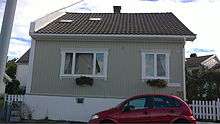Arne Nordheim
.jpg)
Arne Nordheim (20 June 1931 – 5 June 2010) was a Norwegian composer. Nordheim received numerous awards for his compositions, and from 1982 lived in the Norwegian government's honorary residence, Grotten, next to the Royal Palace in Oslo.[1] He was elected an honorary member of the International Society for Contemporary Music in 1997. On 18 August 2006, Arne Nordheim received a doctor honoris causa degree at the Norwegian Academy of Music. He died at the age of 78 and was given a state funeral.
Musical education

At the then Oslo Conservatory of Music (now the Norwegian Academy of Music), where Nordheim studied from 1948 to 1952, he started out as a theory and organ student, but changed to composition, studying with Karl August Andersen (1903–1970), Bjarne Brustad, and Conrad Baden. Then in 1955 he studied with Vagn Holmboe in Copenhagen,[2] and studied musique concrète in Paris. Later he studied electronic music in Bilthoven (1959), and paid many visits to the Studio Eksperymentalne of Polish Radio (1967–1972), where many of his early electronic works were realised (including Pace, Solitaire, and Lux et tenebrae (Poly-Poly)). In 2005, many lost and forgotten tapes of electronic compositions for radio drama for the Norwegian Broadcasting Corporation (NRK) were rediscovered, reminding us that Nordheim also developed his electronic musical language in his home country.[3]
Works
His Essay for string quartet was first performed in Stockholm in 1954, but Nordheim always considered his String Quartet of 1956 as his Opus 1. His musical output is focused around themes of 'solitude, death, love, and landscape';[4] these themes are already evident in his song cycle Aftonland (Evening Land, 1959), a setting of poems by the Swedish poet Pär Lagerkvist, which brought him national recognition. The 1961 Canzona per orchestra was his international breakthrough. Inspired by Giovanni Gabrieli's canzone, the work showcases Nordheim's historical leanings, as well as his occupation with space as a parameter of music. Nordheim's spatial concerns, coupled with his focus on death and human suffering, are brought together in what is arguably his most famous work, Epitaffio per orchestra e nastro magnetico (1963). Written in memory of the Norwegian flautist Alf Andersen, who died that year at a very young age, the work incorporated Salvatore Quasimodo's poem Ed è sùbito sera. Originally conceived for orchestra and chorus, Nordheim realised that his wish to have the whole performance space 'singing' was better achieved with the use of electronic means. The result is a remarkable, almost imperceptible, blending of the orchestral sounds with the choral sounds of the tape, where the final line 'ed è sùbito sera' ('and suddenly it is evening') is the only part of the text that can be heard.
His later compositions include The Tempest (1979), Klokkesong (1984), Magma (1988), the Violin Concerto (1996) and Fonos for trombone and orchestra (2004). Arne Norheim was inspired by the neumes and the sound of the medieval bells in Kaupanger stave church in composing the work Klokkesong, which was first performed in the church. In The Tempest, a ballet based on Shakespeare's play, electronics and orchestral sounds are again mixed, while the focus is more strongly on vocal music (e.g. the 'double voice' of Caliban), while Nordheim's continued use of historical elements is shown by the incorporation of Leonardo da Vinci's musical rebus, which solved reads Amore sol la mi fa remirare, la sol mi fa sollecita.
Draumkvedet is a monumental stage work for orchestra, (acting) chamber choir, soloists and dancers, and was performed 40 times in 1994 with the Broadcasting Corporation Radio Orchestra and Grex Vocalis. A recording featuring these performing forces conducted by Ingar Bergby was made in 2001, and released in 2006 as a two-CD set on the Simax label (Simax PSC 1169). Based on a medieval Norwegian poem (Draumkvedet, The Dream Song), the work was composed in honor of the millennium of the city of Trondheim in 1997.
Astronomical honor
3457 Arnenordheim, a minor planet circling the sun in the main asteroid belt between the planets Mars and Jupiter was named for the composer after its discovery in 1985.
Cultural references
- Arne Nordheim's popularity grew enormously when Frank Zappa arrived in Copenhagen in 1973, and told journalists he wanted to meet Arne Nordheim. Later, Zappa performed in Norway with Nordheim as a VIP guest. A lifelong friendship developed between the two, and Nordheim was invited to the US, while Zappa always visited Nordheim when performing in Norway.[6]
- Norwegian painter Håkon Bleken produced a series of large charcoal drawings inspired by Nordheim's quote that "music lives in the span between poetry and catastrophe".[7]
- "A Study Dedicated to Arne Nordheim" is the title of a track on Hemmelig Tempo's album Who Put John Cage on the Guestlist? (2010).
References
- ↑ "Composer Nordheim dead at 78". News in English.no. Retrieved 2014-06-16.
- ↑ "Information about Arne Nordheim". EWH.DK. Archived from the original on 16 January 2008. Retrieved 2008-01-03.
- ↑ "Ballade review". Retrieved 2010-01-03.
- ↑ Hallgjerd Aksnes, 'Nordheim, Arne', Grove Music Online ed. Laura Macy, article updated 19.04.04,
- ↑ Kaupanger stave church (Kulturminneløypa)
- ↑ "Kulturspeilet". Retrieved 2010-08-26.
- ↑ "Håkon Bleken interview in VG". Archived from the original on 27 July 2010. Retrieved 2010-08-26.
External links
- Arne Nordheim's official web page
- Arne Nordheim interview by Bruce Duffie
- Obituary in The Guardian
| Awards | ||
|---|---|---|
| Preceded by Espen Skjønberg |
Recipient of the Norsk kulturråds ærespris 1990 |
Succeeded by Synnøve Anker Aurdal |